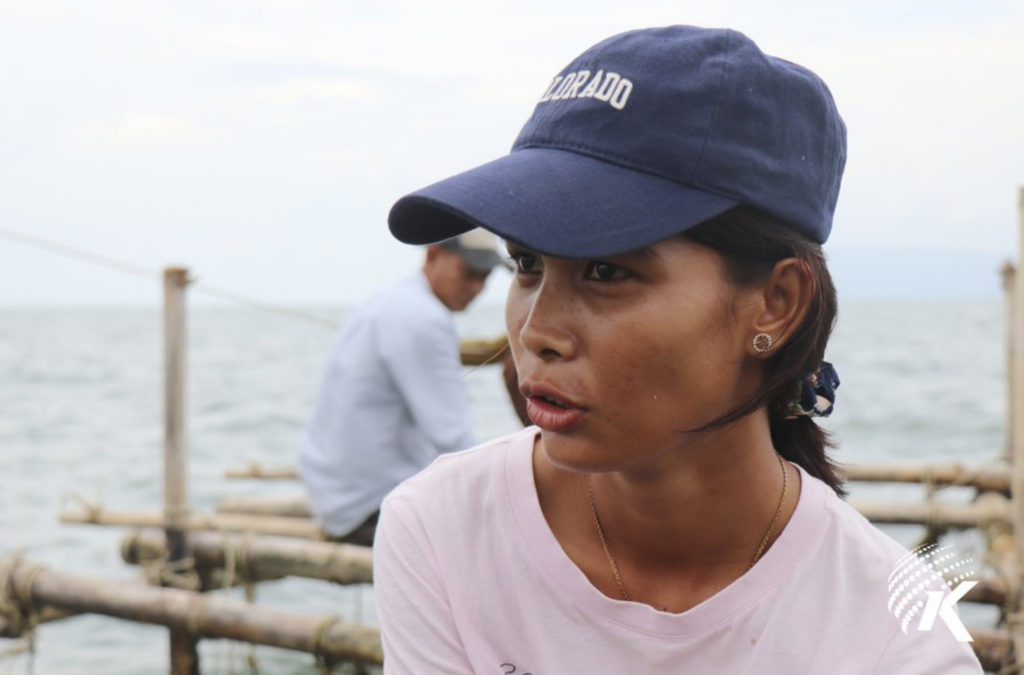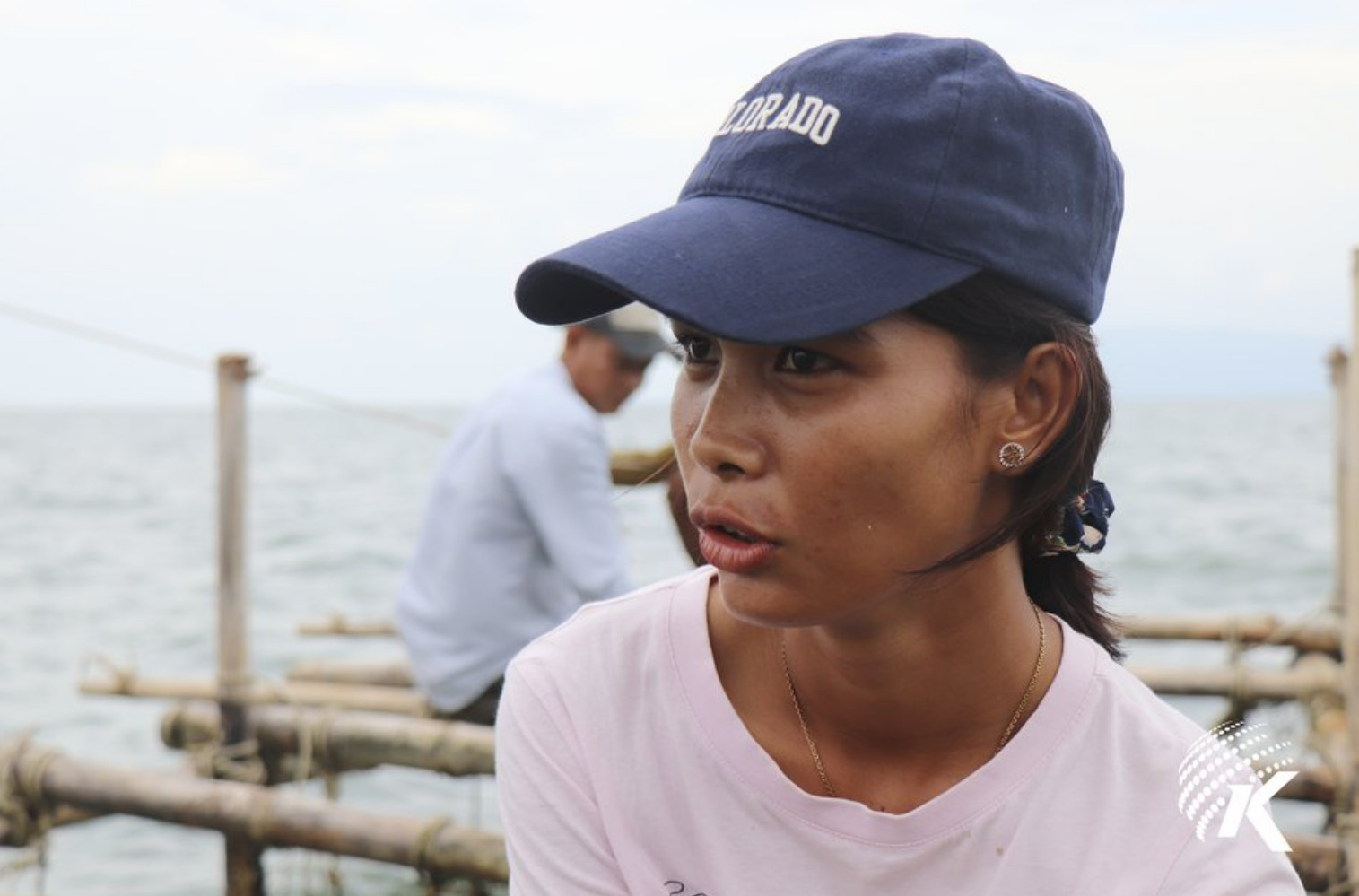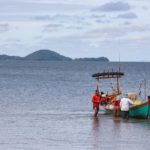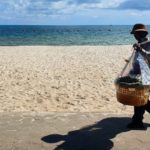KAMPOT PROVINCE – The first young female oyster researcher in Cambodia hopes to introduce oyster farming techniques in coastal communities to transform traditional oyster catching that is risky for livelihoods to a safer method of earning income by selling natural oysters while saving the mollusc that improves the marine ecosystem.

Growing up in the coastal province surrounded by fishermen as her villagers, Tai Chhen always looked forward to what needs to be improved in her community in the way her fellow villagers earn profit from sea fishing.
Chhen is studying fisheries science at college and as part of her research, she dug deep on the internet to dive into the process of feeding oysters. Later on, she learned the techniques of feeding oysters from Vietnam and Thailand and discovered it is beneficial for both the coastal ecosystem and the livelihoods of people who live alongside the coastal area to harvest oysters in a more secure way.
How dangerous is diving for oysters?
Observing and evaluating the risk that oystermen face while diving to collect oysters under the deep-sea level by using the diving equipment that sometimes leads to ear and nose aches, and even death, due to solo diving with broken breathing gas while under the sea pressure, the young oyster researcher, felt the urge to make a change to enable fishermen to catch oysters in a safer way.
After studying oysters for one year, she found a way to help oystermen pursue their earnings from selling oysters by doing oyster farming.
“It is a unique idea and we want to see our citizens [oystermen] cut down on fishery using breathing gas that is used when diving deep into the sea to collect oysters that can cause danger,” she told Kiripost.
She explained, “Because when we dive deep and use only breathing gas, the pressure can cause earaches. Sometimes it is associated with the error of [diving] equipment and can cause a higher risk for them because when they dive [to find oysters], sometimes no one is on the boat to help.”
Usually, when diving about 10 to 20 meters under water, divers cannot rush to the surface immediately as it can cause the bends, a potentially deadly illness that occurs when divers ascend to the water surface too quickly and can cause ear and nose aches or lead to death, according to Chhen.
Currently, Chhen is a community and livelihood coordinator at the Oyster Farm project, is a part of Consortium for Sustainable Alternatives and Voice for Equitable Development (CO-SAVED) project funding to find alternative livelihoods at Marine Conservation Cambodia organization to experiment with natural oyster farming in her Kampot province community. She said the project started in November 2022 and will continue until the end of May. However, it will continue until December to complete the 14-month initial oyster farm project.
“Normally, based on the life cycle of oysters, which is between 1.5 to two years to wait until they are big enough to put on sale in the market, it consumes a lot of time to grow,” she said sat on a bamboo raft of baby oysters.
Once a month, Chhen visits the oyster farm to check whether there are baby oysters on the shells that tie to the rope with a long raft of bamboo. She also monitors how baby oysters are growing. She told Kiripost that if the oysters stop growing, they may be infected by disease.
The importance of oysters for ecosystem
According to a National Oceanic and Atmospheric Administration (NOAA) 2022 publication, there are many factors that affect the water quality and health of oysters, such as runoff water, erosion from industry, farming, and development, which all contribute to lower salinity, low oxygen levels, and silt overload. Waste, toxins, and excess nutrients end up in the water, weakening oysters and increasing the spread of disease.
Chhen added, “It is difficult to track the growth of oysters since they can grow very little from one month to another.”
Oysters are filter feeders, which means they eat by pumping large volumes of water through their bodies. The molluscs eat a type of microscopic plankton called phytoplankton, which they filter into their bodies using their gills. Water is pumped over an oyster’s gills, where plankton, algae, and other particles become trapped. An oyster can filter up to 50 gallons of water a day, according to ‘In A Half Shell’.
“Oysters are a sort of species that filter feeders, they can eat by themselves without needing us to feed it. Even though it might take a longer time, we don’t need to feed it, we just keep it here and wait till it grows enough to harvest,” she said.
Oysters benefit the sea’s ecosystem as when they eat microscopic plankton, they purify the water.
“Wherever oysters exist, they make the water in that area clear so fish and other species can live there,” she said, talking about how oysters can maintain life balance in the ocean.
Preak Ampov village is a place where there is an abundance of oysters and fishermen usually fish for the molluscs there to earn more income.
“Now, the number of oysters is decreasing. I have visited the exact place and it does not have many like they [fisherman] used to say. It is little now, and sometimes it cannot be equivalent to the cost that they spent for gasoline [boat traveling],” the oyster observer told Kiripost.
The rise of fishing oysters is one reason among others that she is considering reducing the volume of oysters in the area.
“Oysters spend about one year to reproduce; we can say it takes a long period of time. As long as we still keep collecting all small and big oysters every day and cannot leave them to reproduce, the reproduction will be slower and we will have less,” Chhen said.
What is oyster farming?
According to Marine Conservation Cambodia, oyster farming is the process of growing oysters in the ocean until they reach market size. The world oyster industry generates more than $10 billion a year.
China is currently the biggest oyster producer in the world. The USA, France and Canada produce less oysters but of a higher quality. Neighboring countries, such as Thailand and Vietnam, also produce many oysters.
Why oyster farming?
There is a high demand for oysters in most domestic and global markets. In the majority of countries, oyster farming only becomes popular after wild populations have disappeared. Oyster farming is not a replacement for collecting oysters from the wild. Rather, it provides more oysters to the market and more income for fishermen.
How to farm oysters?
A baby oyster is small like a dragon fruit seed. It takes 18 to 24 months to grow them to market size.
There are two ways to produce baby oysters. The first is to buy them from hatcheries. The second method is to put shells, cement or other hard objects in the ocean.
After the baby oysters are nurtured, there are different ways to grow them in the ocean, such as floating bag culture, beach culture, fixed bag culture, hanging bag culture and hanging rope culture.
The most popular method in Asia is raft culture that uses cheap materials, such as bamboo and plastic floats. They can be fixed on the ground or floating. Each string can have 10 to 15 oysters. A big raft (10m x 10m) can house up to 588 strings of oyster. In total, a raft can produce up to 8,820 oysters.
MCC plans to recruit 10 fishing families as volunteers, offering basic compensation. They will carry out a trial in 14 months and aim to farm baby oysters from the ocean and feed them for one year.
(Article was published on Kiripost / Publication date 02 June 2023)











